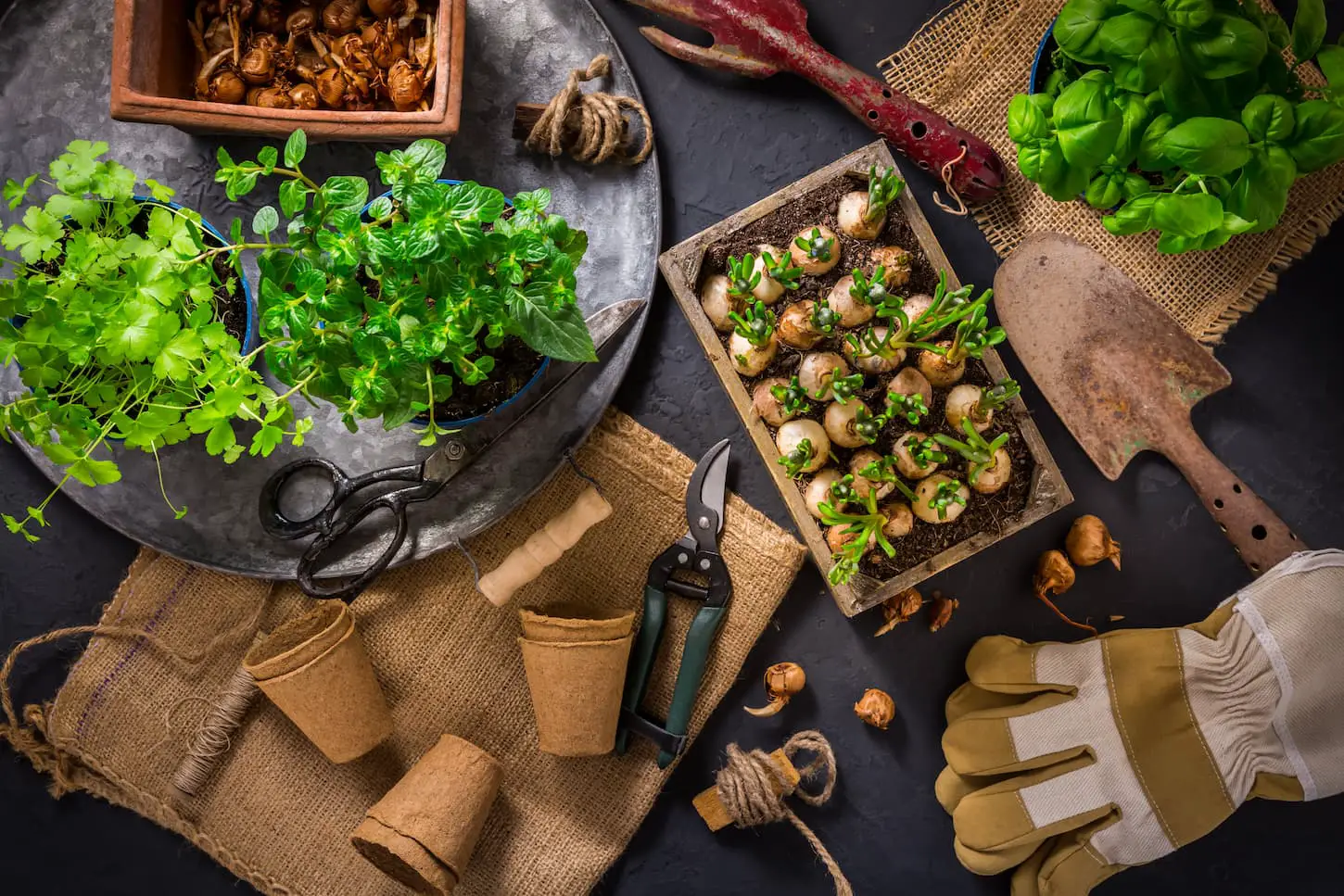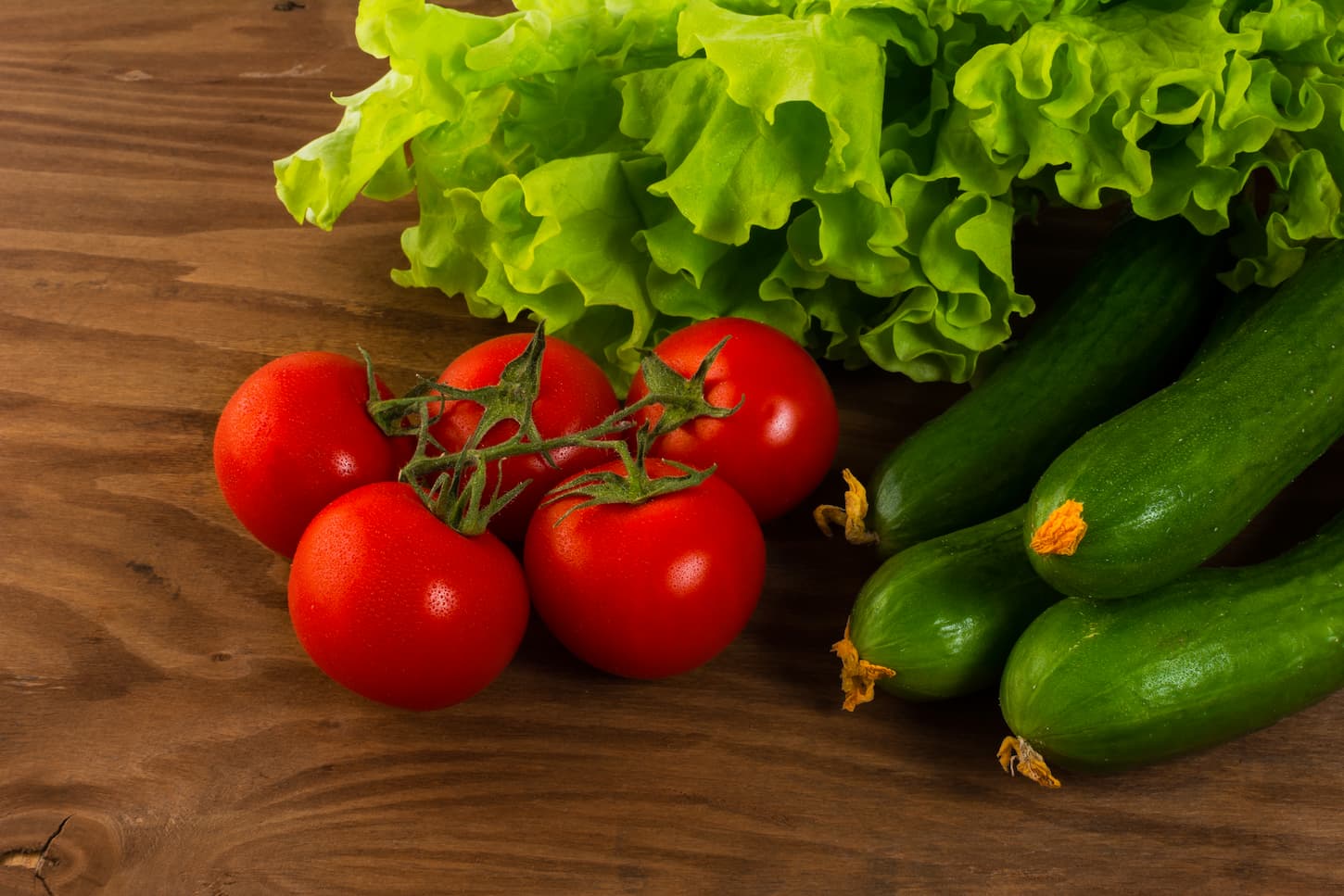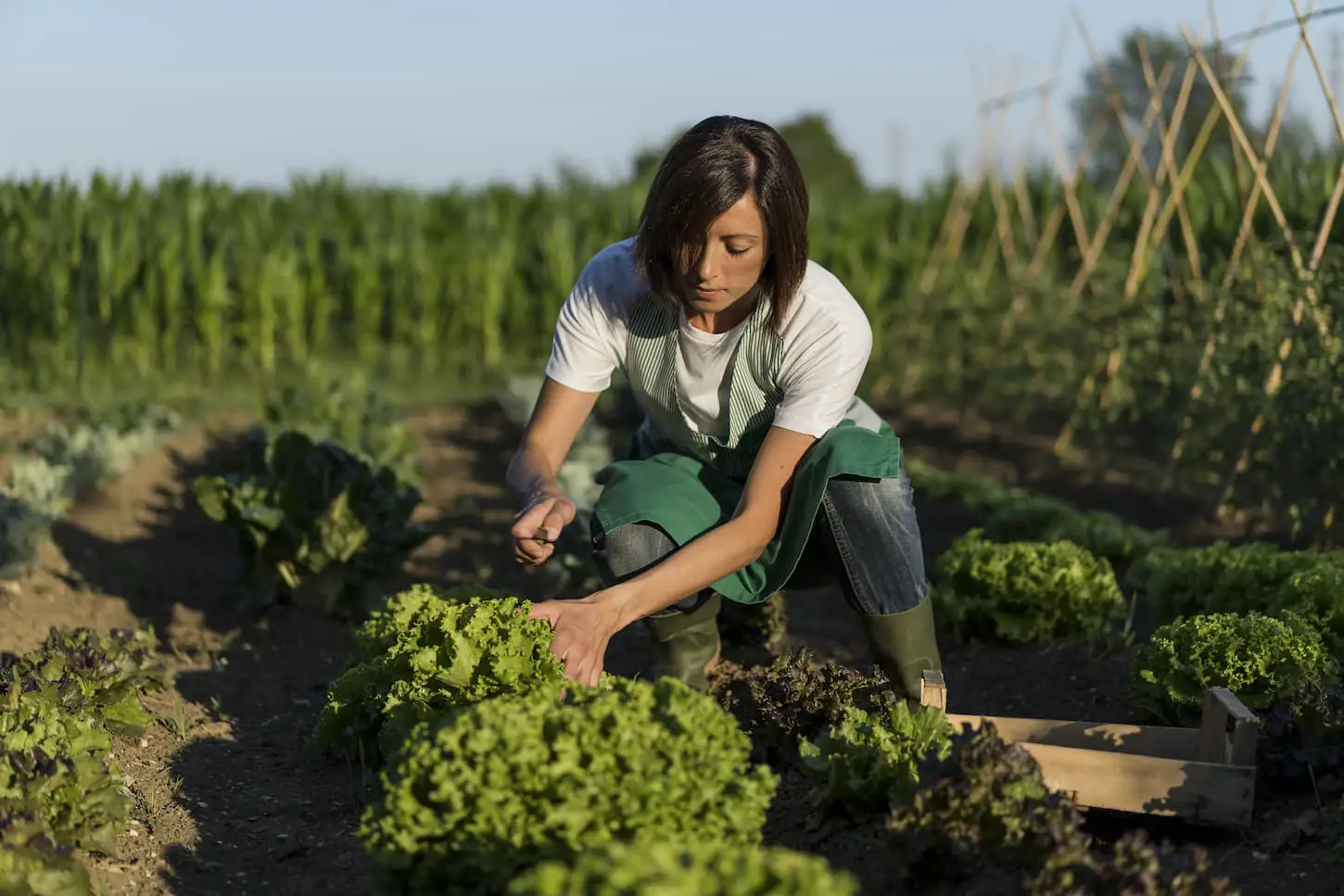Fruits and vegetables are different species of plants, and we usually classify them according to their taste and texture. One way to organize plants in the garden is by looking at how they reproduce, so let’s find out whether vegetables have seeds.
Botanically and scientifically speaking, vegetables don’t have seeds inside them. Vegetables flower and go to seed if left in the ground to mature. So tomatoes, cucumbers, and squash are all technically fruits. We categorize many fruits as vegetables because of their culinary uses.
To get the most from a veggie garden, we need to know about the different plants and their life cycles – including how they reproduce. When we understand reproduction, we can get a seed bank going and improve the quality and yield of our plants.
Want to know more about veggie seeds? Please find all the answers to any questions in our veggie growing guide.

Why Do Vegetables Not Have Seeds?
Vegetables don’t contain seeds because we usually eat the plant part that doesn’t produce seeds, such as the leaves or roots. The seed-forming flowers of a vegetable plant will only appear if the vegetable matter is left to mature in the ground, usually well past when it’s edible.
Fruits and vegetables reproduce in different ways. Most fruits reproduce using sexual reproduction, which means the females grow flowers and need to be pollinated by a male.
Once pollinated, the plant will produce seeds and form a protective fruit around them. When the fruit ripens, birds and animals eat the seeds and disperse them in their droppings.
Some plants, including many vegetables, reproduce through asexual reproduction, which means they don’t need to be fertilized or produce seeds to reproduce.
If Vegetables Don’t Have Seeds, How do they Reproduce?
Most vegetable plants will produce seeds if left in the ground to mature. However, we don’t necessarily need seeds to grow vegetables – we can grow many without seeds. In addition, some vegetables, such as ginger, potatoes, and onions, can reproduce by forming new shoots or bulbs.
Bulb vegetables such as shallots, garlic, and onions can reproduce through asexual reproduction. Once they mature, they will produce new bulbs, which will turn into individual plants.
Some plants, such as potatoes, develop new tubers underground – these thick roots are called rhizomes, and they will produce a new plant.
Most vegetables are biennials, so they take two seasons to mature and produce seeds. So, for example, if we leave carrots in the ground instead of harvesting them, they will flower and produce seeds in their second year.
Unharvested broccoli stalks will turn into flowers, and head vegetables such as cabbage and lettuce will develop a long flower stalk.
Do Any Vegetables Have Seeds Inside Them?
According to biologists, botanists, and keen gardeners, vegetables don’t have seeds inside them. However, in many kitchens and cultures worldwide, many seed-containing fruits are classified as culinary vegetables, including tomatoes and squash.
Most of us aren’t botanists, so generally, we classify things based on their culinary uses. Typically, sweet things are classified as a fruit, and savory things as vegetables, regardless of whether or not they contain seeds.
Therefore, we can use the term “culinary vegetable” to describe best a fruit that we use primarily in savory dishes.
What Are Culinary Vegetables? Do They Have Seeds?
Culinary vegetables are technically fruits because they have seeds inside them. Therefore, a culinary vegetable is a fantastic way to define fruits that have the characteristics of vegetables and which we use primarily for cooking.
To be scientifically correct, we have to use more than just the taste to classify something as a fruit or vegetable. So, to get a clearer idea about culinary vegetables, let’s look at the features that distinguish fruits from vegetables.
Common characteristics of fruit
A fruit will usually develop from the flower of a fertilized plant and contain seeds. Usually, the seeds are on the inside of the fruit, but they can also be on the outside.
Fruits are generally sweet with soft flesh and are usually used in jams and sweet dishes or eaten raw as a snack. Nutritionally speaking, fruits tend to have more sugar, calories, and fiber than vegetables.
Common characteristics of vegetables
Vegetables come from all different parts of a plant, including the roots, leaves, and stalks, and they don’t contain seeds. Vegetable plants will only produce seeds if you leave them in the ground to mature.
Vegetables usually have a savory flavor and tougher skin, and most of the time, they are nicer to eat when we cook them.

Common Culinary Vegetables
Peppers, avocado, cucumbers, eggplant, and squash, are culinary vegetables and are often used in savory dishes and have the characteristics of vegetables. Most people call these plants vegetables, but they have seeds inside, so technically, they are fruit.
Below, we’ll take a deeper look at the most common culinary vegetables:
#1 – Tomatoes
Tomatoes have fruit characteristics; they’re sweet, contain seeds, and have soft flesh. We can eat tomatoes raw, but they’re used a lot in savory dishes – thus, most people call them vegetables. In the USA, tomatoes are officially a vegetable.
#2 – Avocados
Avocados have tough skin, but they’re soft and creamy inside and can be eaten raw or enjoyed in savory meals. The massive seed in an avocado means it’s technically a fruit – a large berry.
Nutritionally speaking, avocados are more similar to a vegetable than a fruit, and in the USA, avocados are officially a vegetable.
#3 – Green beans
Green beans are used almost exclusively in savory dishes, and most people would call them a vegetable. However, beans are from the legume family of plants, and beans are seeds that come in a seed pod, so green beans are technically a fruit.
#4 – Eggplant, bell pepper, chili peppers
Eggplant, bell pepper, and chili peppers come from the nightshade family of plants, including tomatoes. It might be hard to believe, but chilies are a fruit because they have their seeds inside.
#5 – Cucumber, squash, pumpkins, zucchini
Cucumber, squash, pumpkin, and zucchini are part of the gourd family of plants, including melons. Gourds are fruits because they have seeds inside even though they have the characteristics of vegetables, such as a savory taste and thick skin.
Most gourds taste better when cooked, except cucumber, popular in salads.
Where Veggie Seeds Come From and How to Harvest Them
Like most plants, vegetable seeds come from the flower of the plant. The only difference is that the flowers and seeds take longer to mature. We can harvest the seeds from vegetable plants once they dry out, either by doing it ourselves or waiting until the following year.
Harvesting seeds involves a bit of extra work, but it can save money, and it’s a great way to keep quality plants going. In addition, if we use our seeds, the plants will be more adaptable to the climate and may produce higher yields.
If we want to harvest seeds, then we need to leave our most potent, most robust plants in the ground to mature. Plants pass down their genetic traits, so more robust plants will produce the best seeds.
It takes two years of biennials such as carrots, beetroot, leeks, and parsley to produce seeds, so don’t harvest them till the following season.
Leave vegetables in the ground over winter and harvest the seeds in summer. Seeds that are ready to harvest will be brown and dry.
Each plant is different, and brassicas such as kale, broccoli, and the rocket will develop large bright yellow flowers and then delicate seed pods. You can harvest these pods when they turn from green to yellow.
To harvest large seed heads such as coriander or lettuce – cover the head with a brown paper bag and shake the seeds in. After harvesting them, use a sieve to separate the dried plant matter from the seeds.
Store the seeds in an airtight container in a cool, dry place with a steady temperature – ideally between 32 and 41 Fahrenheit.
How to Grow Vegetables Year After Year
To grow vegetable year after year, we can collect seeds from our plants and start a seed bank. We can also regrow some vegetables from cuttings or root division, and we can reproduce new plants from kitchen scraps.
If it’s your first year growing vegetables, buy seeds or baby plants to start the garden off. Then, when there is a healthy crop of vegetables, they can be reproduced using one of several methods – which we’ll explore below.
Step #1 – Seeds
Most gardeners will start their garden off with store-bought seeds. However, once the garden is established, we can keep seeds from the plants to grow the following year.
It takes a bit more time and effort to harvest our seeds, but it’s a fantastic way to keep a favored plant growing, and it will save some money.
Step #2 – Division
The division is a popular method of asexual reproduction, and we can use it to produce more plants from vegetables that grow in clumps, such as leeks and onions. Vegetables that grow in clumps develop thick roots known as rhizomes, which eventually mature into independent plants.
To grow new plants from division, we need to dig into the earth to find a rhizome. Then, use a sterile garden knife to remove the rhizome and replant it. After a few weeks, we should see the shoots of a new plant sprout from the ground.
Step #3 – Cuttings
Growing plants from cuttings are one of the most popular ways to produce new plants. To grow from a cutting, remove a part of the large plant, such as a leaf or stem.
Place the cutting in water until it develops roots, and then plant it in the ground. Some gardeners like to use root-growing products to help their cuttings establish roots.
In case you’re wondering if you can grow spinach from a cutting, make sure you check out my article: Can You Grow Spinach from Store-Bought? 5 Tips to Grow! It talks about using store-bought spinach to get a cutting, so you’ll want to check it out.
Step #4 – From scraps
We can grow many vegetables from their leftovers after harvest. Growing from scraps is a fantastic way to reduce food waste and regrow vegetables yearly. Here are some vegetables we can regrow from scraps.

Leafy vegetables
We can regrow most leafy vegetables, such as lettuce and pak choi, from their leftover stem – the hard piece at the bottom that we don’t eat. Take the stem, put it in a small container, and add enough water to cover the bottom of it.
Please keep it in a warm, bright place, and add fresh water as necessary. Once the stem has developed roots, we can plant it in the ground, where it will regrow.
We can also regrow leafy vegetables from individual leaves. Use a sterile knife or scissors to cut a leaf at the base and put it in a container with some water covering the lower leaf. Plant the leaf in a pot or straight into the ground when the roots appear.
We can also harvest the head of leafy vegetables such as lettuce and leave the stem in the ground. After a few weeks, the stem will regrow into another lettuce.
Bulbs
It’s easy to regrow bulb vegetables such as spring onions, fennel, leeks, and lemongrass. Cut the bottom 1 to 2 inches off the plant – the part with the bulb and roots.
Place the piece in a shallow container and cover the roots with half an inch of water. The roots will get longer, and we can transfer them to the soil.
You’ve probably noticed that large bulbs such as onions, shallots, and garlic will often produce a shoot from the top after harvest. Therefore, they can be planted with sprouts directly into the earth with the shoot poking up above the soil.
Roots
Root vegetables can be regrown from their tops – such as beets, carrots, and turnips. Cut off the tops, put them in an open container, and cover them in an inch or two of water. Use the leaves as they regrow or place the tops in soil when they develop roots to produce new plants.
To regrow leftover potatoes, wait till they form “eyes.” Then, cut the potatoes into pieces, each with its own eye. Plant the potato pieces with eyes in the ground to grow new potato plants.
Ginger will also form a shoot if it’s left long enough. Plant the ginger along with its root to regrow ginger plants.
Best Products For Growing Vegetables
When you’re gardening, having the right tools can make a huge difference. Here are some of my favorite gardening tools to use in my backyard homestead.
Best veggie garden products
When you’re planting veggies, you’ll want these products on hand. I’ll cover the tools in a moment. These are just plant-related products.
- Mycorrhizae root booster – definitely add this to trees, but it can help when you’re planting veggie seedlings, too. You can get it from your local nursery or on Amazon (click here to see it).
- Nursery planting pots – it really helps to have pots for starting seedlings at home. Ceramic is better than this plastic set on Amazon, but it’s hard to beat the better price of the plastic options. Just be sure to use and reuse them.
- Going to do a lot of cuttings? You’ll want a terrarium to make it happen. This one from Amazon looks really cool – I want it for my kitchen windowsill!
- You’ll want compost. If you can, I recommend you make your own. Vermicompost is a great option, and it’s what we use. This is the vermicompost setup I got from Amazon. If raising worms to get compost isn’t your thing, though, you can make compost or just buy it from Amazon or your local nursery.
If you’re wanting a raised bed garden (but you don’t already have one), I did a ton of research to figure out what materials work best. You can read the research here, or just know that the material doesn’t matter. Get a good price on a garden bed, like this one on Amazon.
Best tools
- Best getting-started gardening kit – if you don’t have any of the gardening tools, get a basic kit (like this one on Amazon), to get you started. You can always upgrade to the better tools later, but at least this way you’ll have the basics covered.
- Best tools to upgrade first – if you don’t already have a digging and weeding tool, this weeding knife on Amazon is a great way to upgrade your gear quickly from the basics to a next-level gardener.
- The #1 best gardening tool ever – if I could only ever have one gardening tool ever, I’d have to pick my Cape Cod weeder. You can get them on Amazon (click here to see what they have available), but I got mine from Red Pig Garden Tools.
I’m not an affiliate partner with them, if only because they don’t have affiliate partners at all. Even so, they have the hands-down best gardening tools and products I’ve ever used. If you’d like to check out or shop Red Pig Gardening tools, here’s a link to their website.
Here’s what I’ve gotten from their site. Again, I’m not affiliated with them. I bought their products on my own and I’ve been that impressed.
- Cape Cod Weeder (short handle) – this one is my favorite!
- Weeding fork (long handle)
- Cape Cod (long handle)
- Diamond hoe (long handle)
These tools make any gardening project a ton easier – especially when you’ve got a lot of weeding to do!

Key Takeaways and Next Steps
Vegetables don’t produce seeds in their first year, but if we leave them in the ground, they will eventually flower and produce seeds the following season.
We don’t have to have seeds to grow new vegetables – many plants such as onions and potatoes will reproduce through asexual reproduction. We can also grow vegetables from cuttings, root division, or even kitchen scraps.
Speaking of culinary vegetables, make sure you read the answer to the commonly-asked question, Are Coffee Grounds Good for Tomato Plants? next!
Resources
It’s important to learn from your own experience, but it’s also smart to learn from others. These are the sources used in this article and our research to be more informed as homesteaders.
- Bauholz, Henri. “How is Fruit Formed in Plants?” Sciencing, 2 Mar. 2019, sciencing.com/fruit-formed-plants-6496874.html.
- “Biennial | Plant.” Encyclopedia Britannica, www.britannica.com/science/biennial. Accessed 21 May 2022.
- “List of Culinary Vegetables.” Academic Dictionaries and Encyclopedias, en-academic.com/dic.nsf/enwiki/83267. Accessed 14 May 2022.
- Miller, Zoë. “10 ‘fruits’ That Are Technically Vegetables — and Vice Versa.” Insider, 12 Dec. 2018, www.insider.com/fruits-that-are-vegetables-2018-12.
- “Saving Vegetable Seeds.” UMN Extension, extension.umn.edu/planting-and-growing-guides/saving-vegetable-seeds#storage-823211. Accessed 21 May 2022.
- “Sexual and Asexual Reproduction – Reproduction in Plants – GCSE Biology (Single Science) Revision.” BBC Bitesize, www.bbc.co.uk/bitesize/guides/z2xg87h/revision/1. Accessed 21 May 2022.
- “The Many Different Types of Cucurbits.” University of Illinois Extension, 7 May 2020, extension.illinois.edu/blogs/good-growing/2020-05-07-many-different-types-cucurbits.
- “Vegetable Farming – Propagation.” Encyclopedia Britannica, www.britannica.com/topic/vegetable-farming/Propagation. Accessed 16 May 2022.
